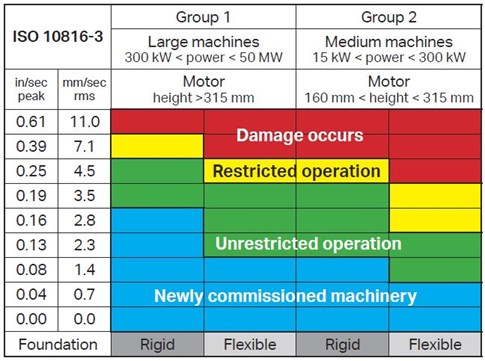- Some of us have cited '10816-1'. ISO '10816-3' is a more specific sub-part.and, I believe, more accurate for my purpose of measuring machine casing measurements. I am using ISO10816-3 and Technical Associates as a guideline. Most of the time, trending is a better option for vibration monitoring, IMO.
- Permissible exposure limits for vibrations are established by entities such as the International Standards Organization (ISO). ISO vibration regulations include: - DIN ISO 10816 (vibration severity in machines) - DIN ISO 7919 (mechanical vibration) - DIN 4150 (structural vibration, buildings) - DIN ISO 10816-3 (machine condition, machine.
- Iso 10816 3 Vibration Severity Permissible exposure limits for vibrations are established by entities such as the International Standards Organization (ISO). ISO vibration regulations include: - DIN ISO 10816 (vibration severity in machines) - DIN ISO 7919 (mechanical vibration) - DIN 4150 (structural vibration, buildings).
- ISO 10816-3 - Mechanical vibration – Evaluation of machine vibration by measurements on non rotating parts Part 3 – Industrial machines with nominal power above 15 kW and nominal speeds between 120 r/min & 15000 r/min when measured in situ. Application of this Standard.
ISO 10816-3 defines four groups of machines, ranked according to size, base and purpose. It separates the working conditions into four zones: Monnit’s Standard Vibration sensor (with a frequency range of 10 to 200 Hz and vibration range from 0 to 600 mm/s (¹) is well suited to measure systems identified by ISO 10816-1.
Monnit Standard Vibration Sensors and ISO 10816
Vibration Monitoring has its roots in maintenance engineers inspecting machines during their traditional walk around. It attempts to formalize an instinctive understanding that a machine is vibrating unusually.
ISO 10816 establishes the general conditions and procedures for measurement and evaluation of vibrations from the non-rotating parts of machines (essentially the vibrations transmitted from the moving/rotating parts of the machine to the non-moving parts of the machine).
Standards provide guidance for machines operating in the 10 to 200 Hz (600 to 12,000 RPM) frequency range. Examples of these types of machines are small, direct-coupled, electric motors and pumps, production motors, medium motors, generators, steam and gas turbines, turbo-compressors, turbo-pumps and fans. Neo geo rom set download. Some of these machines can be coupled rigidly or flexibly, or connected through gears. The axis of the rotating shaft may be horizontal, vertical or inclined at any angle.
ISO 10816-3 defines four groups of machines, ranked according to size, base and purpose. It separates the working conditions into four zones:
- (Zone A Green): vibration values from machines just put into operation
- (Zone B Yellow): continuous operation without any restrictions
- (Zone C Orange): condition is acceptable only for a limited period of time
- (Zone D Red): dangerous vibration values - damage could occur at any time


Monnit’s Standard Vibration sensor (with a frequency range of 10 to 200 Hz and vibration range from 0 to 600 mm/s (¹) is well suited to measure systems identified by ISO 10816-1. Cia to 3ds converter citra android.

Vibration Standards Iso 10816-3
For more advanced vibration analysis needs see the Advanced Vibration sensor.
International Standard Iso
ISO 10816 table
Mounting Table
1. Trials in tainted space quick credits. The latest version of firmware and iMonnit software is capable of measuring up to 600 mm/s. Firmware versions before 16.34.22.10 are not capable of measuring above 25.5 mm/s.